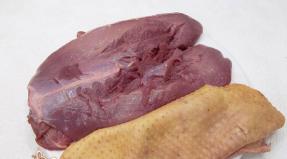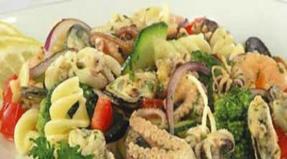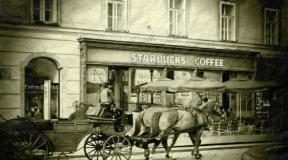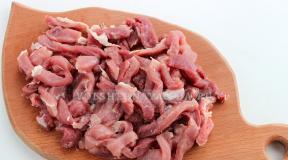Italian coffee - for true gourmets. History and culture of coffee in Italy
The Italians call the invigorating drink not just coffee, but rather attach it to their culture. This country and coffee are absolutely identical things. As much as the natives here absorb Italian coffee, they do not drink in any country in the world. At the same time, it is fried in several technologies, several types are distinguished, which we will discuss in this article.
Bean roasting methods
In order for coffee to have a new flavor every time, it is necessary to carefully roast its beans. Coffee in Italy has four preparation options:

At the same time, the grains that are needed for Italian coffee have a darker color than in other cases. This type of drink is highly respected in southern Italy, but in the CIS countries it was not so well received, however, there were still lovers of this degree of roasting. A distinctive feature of the southern Italian roast is even the fact of a certain burntness - this is normal. Yes, and coffee, after all the impact on it, acquires a slightly bitter taste, which real gourmets can appreciate.
Varieties of Italian caffe
Italians drink so many varieties of coffee that "normal" nations can't even dream of it. They drink a cup in the morning to wake up, after a portion at breakfast, then the turn of snacks comes or instead of them, and after that it is necessary to enjoy their favorite drink after eating, what can we say about dessert? 
The list of popular drinks includes:
- Caffe espresso (espresso), which also received its second name - normale.
It is brewed in a tiny cup and not even completely filled, but only half. Such Italian coffee is drunk everywhere in Italy, and in the CIS it is quite popular, but it is in the latter countries that it does not always look like the original. 
- Caffe ristretto (ristretto) is an abbreviated form of espresso.
This is still the same caffe espresso, but designed for one “bite”, since there are only 20 grams of coffee, so it is only enough for one sip. According to the Italians, this type of caffe is more intense and has a fragrant taste, unlike the classic espresso.
- Caffe lungo - the same caffe espresso, but with more water.
As you can see, long (lungo) coffee is another variation of espresso, but now more water is simply added to it to prolong the pleasure. In this case, the drink turns out to be less saturated, but it receives more caffeine due to the longer brewing process than espresso.
- Caffe corretto is a small "bonus" to the usual flavor.
If someone is tired of the classic aroma of coffee beans for a while, then craftsmen in Italy will offer you Caffe corretto. There, a little more liquor or grappa is added to the usual espresso. 
- Caffe macchiato - the same espresso, but with a small portion of milk.
In fact, it is done a little differently, but it just gets dirty with a small drop during cooking! milk.
- Caffe schiumato - here they already stain with a drop of whipped milk.
- Cappuccino is a good old cappuccino.
This is a caffe that contains a large amount of milk foam, and in some cases it is quite successfully sprinkled with grated chocolate or cocoa powder, which results in good patterns that please the eye. Baristas go crazy over milk - making all sorts of drawings on coffee in the form of curls and hearts, the so-called latte - art. Italians usually drink this type of coffee for breakfast, where, in addition to cappuccino, there is also orange juice and a croissant.

This is a large kettle of water and weakly brewed coffee. According to local Italians, this is just l'acqua sporca, which means "dirty water".
- Caffe d'orzo is a barley version of coffee.
Its advantage is that it is not a traditional caffe, but it does not contain caffeine.

Italian coffee and milk: what for what
Coffee, which is diluted with milk in Italy, is called Caffellatte, but it has become so popular in all parts of the world. Here the technology of preparation of the drink is important. Hot milk is simply poured into espresso in proportions one to one. But on top it covers the finished product with a small layer of already foamed milk.
Cappuccino is similar to latte, especially since the Italians themselves call it coffee with milk, but in Italian. When preparing it, three parts of hot steamed milk are poured into one part of caffe. When coffee is added to the foam, creating intricate patterns, then it means that it has come to latte art. Cappuccino is served with a spoon, as they first enjoy the foam, and then it's their turn to drink coffee.  Italians are not limited to the usual Caffellatte, so they also came up with Latte macchiato. It's just the opposite, when milk is poured into espresso. As for the terminology, it is basically a cocktail of milk foam, milk and coffee. Here, one part of coffee goes to three parts of milk. At the same time, a glass is chosen with high walls, where foamed milk is placed first, and then the turn of espresso comes, going into a cocktail in a thin stream. The layers should not mix.
Italians are not limited to the usual Caffellatte, so they also came up with Latte macchiato. It's just the opposite, when milk is poured into espresso. As for the terminology, it is basically a cocktail of milk foam, milk and coffee. Here, one part of coffee goes to three parts of milk. At the same time, a glass is chosen with high walls, where foamed milk is placed first, and then the turn of espresso comes, going into a cocktail in a thin stream. The layers should not mix.
Trademark Lavazza: the centuries-old tradition of Italian coffee
The brand of Italian has been living in the minds of the locals since about 1895. She absorbed all the best in the Italian drink. When you want to try real caffe from Italy, it is better to turn to this brand. The release form of Lavazza is suitable for different types of coffee machines, as well as for cooking at home.
The range of this brand is impressive: beans, ground, capsule type and coffee pods. In Italy, somewhere around three out of four Italians will always choose Lavazza over other coffee brands. The popularity of this brand was not without reason, because only the best varieties of grains are used to create a product. 
Lavazza coffee blends include:

The blend includes varieties of grains from the plantations of South and Central America, Indonesia and Brazil.
The difference between this drink is considered to be a creamy structure and a persistent taste, what can we say about the aroma - it is magical.
If you choose Decaffienato or Rombouts Decaffienated, then this decaffeinated coffee is both tasty and healthy.
Try drinks from Lavazza and other Italian brands, and you are sure to find something for yourself. 
Italian coffee - the best moments of your day
Fragrant, like the air of the Mediterranean Sea, saturated, like the colors of southern nature, hot, like the look of a black-eyed senorita - all this is it, the unique and unforgettable best Italian coffee. It is impossible not to fall in love with him. Who ever tried this drink, forever captivated by its taste.
A tradition of daily enjoyment
Italy is a state where the secrets of making coffee are carefully kept and passed down from generation to generation. For the inhabitants of the country, this is not just a drink, it is a delight that Italians pamper themselves with at any time of the day.
Today, the Apennine Peninsula is considered a coffee state. But it was not always so. Unusual grains brought from distant countries did not find demand among residents. However, with the light hand of a local scientist, who at the end of the 16th century published a treatise on the benefits of a drink made from such overseas seeds, they began to sell it as a medicine.
But due to the high cost, the product was available only to the local elite. An average-income Italian could not afford such a “medicine” even after the coffee trade was approved by Pope Clement VIII. It only became more accessible when coffee plantations began to be grown in the American colonies.
The first institution where this divine drink was served opened in the middle of the 17th century. A lot has changed since then. The delicacy began to be prepared on automatic equipment, and a great variety of coffee compositions appeared. Each family has its own recipe, which is passed down from generation to generation and has its own unique flavor that distinguishes the drink with its unique refinement and aroma.
Perfection in every cup
In Italy, food and drink are elevated to a kind of cult. There is hardly a person who would not elevate such things as pizza, spaghetti, wine, coffee to the ranks of the sacred. The most popular drink among the inhabitants of the Apennine Peninsula is espresso. Fragrant, invigorating, not a single meal can do without it. Italians believe that a cup of strong coffee helps to digest food better. In every cafe, restaurant they make several recipes for this drink.
The most popular types of Italian coffee:
1. Espresso Romano. This drink is served with lemon.
2. Cappuccino. Famous recipe with milk.
3. In ghiaccio. Popular composition with ice.
4. Frappuccino. This delicacy is consumed cold. In addition to coffee, it contains caramel syrup and fresh cream.
5. Macchiato. Very strong drink with foamed milk.
6. Nocholla. Coffee with cream, cream and nuts.
7. Corretto. Drink with alcohol.
8. Look. The famous ice cream recipe.
9. Lungu. Espresso diluted with hot water.
10. Mochachino. Freshly prepared drink with milk and chocolate.
11. Bicherin. The composition includes freshly brewed coffee, liquor, cream, chocolate.
Each of the drinks has a rich unique taste and extraordinary aroma that captivates with its perfection. Anyone who has ever tasted Italian coffee will never exchange it for any other.
The most famous varieties and producers of Italian coffee
Although coffee trees are not grown on the Apennine Peninsula, the country is considered one of the leaders in the processing of this product. Grains are imported from other states, and on the peninsula they are processed and packaged. Italian coffee varieties are known in almost all countries.
This was the production of such companies:
1. Illy. Coffee from the best types of Arabica. The drink of this brand has a unique taste and aroma. The manufacturer offers products in grain, ground and portioned form.
2. Lavazza. There are many blends with different roast levels. The brand offers consumers ground coffee, grain, in pods, capsules.
3. Kimbo. Available for sale in grain and ground form. The difference between the products of this brand is a special roasting with hot air. As a result, the grains acquire a unique aroma and taste.
4. Trombetto. It can also be found in portioned, grain and ground form.
Our online coffee shop from Italy offers the best products from the most famous producers. If you, like us, appreciate a quality, tasty, aromatic drink, call the above number. We will help you make the best choice and quickly complete your order.
Currently, the word "coffee" refers to a drink, most often hot, obtained by brewing ground beans of the coffee tree. In literal translation from Arabic, the name coffee sounds like an exciting drink..
Indeed, after drinking the drink, a strong stimulating and exciting effect is felt, due to the content of caffeine in it.
Today, the real magic of this drink with a charming aroma can be found by visiting Italy. After all, it was there that coffee turned into a part of national cuisine, inseparable from, and. Arriving in Italy, you can try at least one of the many varieties of coffee served in Italian bars. And after tasting this rich, strong drink in its pure form or with the addition of milk foam, ice cream, liqueur or lemon rediscover all facets of its taste.
Origin
No one will probably undertake to say for sure when and by whom coffee was discovered. One version of the origin of coffee throws us back to 900 BC.
It was then, according to legend, that one of the Ethiopian shepherds drew attention to the very active behavior of goats after eating red berries on one of the trees. Having tasted these berries, the shepherd felt how his body was filled with strength and energy. It was in this area of Ethiopia called Kaffa that the coffee tree and coffee, a drink obtained from it, found its name.
Since then, the fruits of the coffee tree have tried to be processed in a variety of ways. The grains were dried, boiled, crushed, made a tincture. And all this for the tonic effect of coffee beans. Over time, the Ethiopian lands were occupied by the Arabs, and the habit of using a tonic product took root among the new inhabitants. They grinded raw grains, mixed them with fat and made balls that were very convenient to take on the road. Raw coffee beans are small nuts that contain caffeine. Therefore, the resulting ground product could both feed and invigorate travelers during long journeys.
Only after many centuries, experiments with coffee beans came to the initial purification, subsequent roasting and grinding in order to further brew the resulting powder.  The resulting aromatic drink could not be compared with the initial attempts to consume coffee beans. Historians say that the first coffee tree seeds were roasted in Yemen in the 11th century AD. In addition, the Arabs began to add cinnamon, ginger and other spices to the coffee drink when brewing.
The resulting aromatic drink could not be compared with the initial attempts to consume coffee beans. Historians say that the first coffee tree seeds were roasted in Yemen in the 11th century AD. In addition, the Arabs began to add cinnamon, ginger and other spices to the coffee drink when brewing.
By the middle of the 15th century, coffee reached the territory of Turkey. The Easterners liked it so much that the ministers of the church had to curse the coffee with the name of the prophet. After all, they saw that believers began to spend much more time in coffee houses than in prayer. Over time, however, the Church's dislike of coffee faded.
Along with the widespread use of coffee, the art of making this drink appeared. Places where coffee was prepared in public began to appear everywhere. Coffee houses became a meeting place, and coffee served as an occasion for pleasant friendly communication. The image of coffee houses gradually moved to Europe over time. And their inner world is reflected in modern cafes.
Coffee came to us from Turkey. However, the bitter drink could not take root in the Middle Ages in Russia. However, in the 18th century, Peter I began to insist on drinking coffee, believing that it contributes to the agility of the mind. And after 1812, drinking coffee in Russia began to be considered a sign of good taste.
History of espresso
Recently, going to cafes and drinking coffee has become fashionable, and such a way of life has appeared. Invite friends not to your home, but to a cafe for a cup of coffee. When ordering a classic espresso, we don’t even think that this brewing method was invented in Italy, and then spread widely around the world. And today, residents of America and Europe, as well as the Middle East and Asia, prefer just such coffee.
The first espresso machine was introduced in Italy in 1905. The principle of its operation was based on passing water condensed from steam under pressure through ground coffee. The taste of the resulting coffee was radically different from the modern drink. Due to the strong overheating, the coffee acquired a burnt aftertaste. The bourgeoisie became the main consumers of such coffee, and a little later the method of preparation spread to Germany and France.
In the middle of the 20th century, there was a strong change in the approach to making coffee. Steam has been expelled from the espresso machine. Instead, the water was heated to no more than 92 degrees and passed under great pressure through the coffee. It was then that the taste of espresso that we know today was born. Gradually, the devices improved, and now espresso is made very quickly and with precise temperature observance.
Types of coffee trees
In total, there are about 200 varieties of coffee trees in the world. Of these, only 20% is used by humans. And only 2 main ones are of interest to coffee connoisseurs. Arabica coffee (Coffea Arabica), called Arabian, and Robusta coffee (Coffea Canephora), called Congolese. 90% of the coffee consumed comes from the fruit of these tree species. 
Arabica
The Arabian coffee tree is considered the most popular type of coffee tree. 70% of the world's coffee is produced from its fruits.
The natural height of this tree reaches 6-8 meters, however, for the convenience of harvesting, it is not allowed to grow more than 4 meters.  Arabica fruits are red in color and turn purple at the end of ripening. The length of the fruit can reach 15 mm. The plant is very capricious to climatic conditions and sensitive to diseases and pests. During the year, one tree produces about 5 kg of fruit, from which up to 1 kg of finished coffee beans is obtained.
Arabica fruits are red in color and turn purple at the end of ripening. The length of the fruit can reach 15 mm. The plant is very capricious to climatic conditions and sensitive to diseases and pests. During the year, one tree produces about 5 kg of fruit, from which up to 1 kg of finished coffee beans is obtained.
Arabica fruits contain 18% aromatic oils and about 1.5% caffeine. The taste of Arabica in the finished drink is sweetish with a slight sourness. The best varieties of Arabica are Bourbon, Maragogype and Typica.
Robusta
The height of the Kanefora coffee tree or simply Robusta in nature can reach 10 meters. But with mass cultivation, it is pruned and arranged in the form of small trees. Robusta flowers are pale pink in color, and the fruits are greenish or brownish-grayish.
This tree was first discovered in the Congo Basin in Africa. Today, Robusta trees are grown both in Africa and Asia, mainly on lowland plantations. The plant is quite unpretentious in care. It tolerates temperature changes well, resistant to diseases and pests. In a year, up to 15 crops can be harvested from a Robusta coffee plantation. It is because of the unpretentiousness and high yield that it is very profitable to grow Robusta.
Robusta fruits contain 8% aromatic oils and up to 3.5% caffeine. The taste of this type of coffee is very specific and quite strong. Because of this, it is most often used to add strength to coffee blends. The taste of Robusta also improves during the production of instant coffee. Despite the lower palatability compared to Arabica, Robusta makes up 30% of all coffee produced.
Arabica and Robusta, in turn, are divided into many varieties depending on the region of origin. All varieties differ from each other both in taste and aromatic properties.
In addition to varieties, there is also a coffee classification according to the quality of the grains obtained. For example, SHG - coffee from the mountainous regions, HG - coffee from the foothills, MG or CS - coffee from the lowland plantations; HB - coffee with hard grains; A - best quality coffee, B - average quality coffee, C - poor quality coffee, AA - best, AB - good, BA - average, BB - low quality.
Culture of preparation and consumption

In Italy, they love coffee so much and drink it so much that they have come up with many ways to prepare it. Italians prepare coffee for breakfast, together or instead of smoke breaks and, of course, after a meal, along with dessert.
The classic type of coffee, also called “normale” (from “normale” - ordinary), is considered espresso. What is served in Russia and the countries of the former Soviet Union, like espresso, is most often very different from its Italian counterpart.
Italian espresso is a velvety dense foam with a golden sheen that covers the entire surface of the coffee in the cup, a soft aroma that fills the whole room and makes you forget about everything. The perfect, balanced, pronounced taste of real Italian espresso cannot be described in words.
According to the rules of coffee etiquette, espresso is served in a thick-walled porcelain cup shaped like a truncated ellipse. The standard volume of such a cup is 75 ml, but the contents, depending on the type of coffee, should take from 25 to 50 ml. This serving maximizes the taste and aroma of coffee. In bars, a special master, called a barista, is engaged in brewing coffee.
Kinds
The most popular type of coffee is, of course, espresso . Its smaller version is ristretto is a standard serving of ground coffee, but in the amount of 1 sip, i.e. 20 ml. This coffee contains more flavor and less caffeine than its classic counterpart.
lungo
lungo This is espresso diluted with hot water to double its volume. Such coffee contains more caffeine, due to the longer passage of water through the ground coffee.
Cappuccino
Cappuccino – espresso with a lot of milk foam reaching to the rim of the cup. From above, airy foam is sprinkled with cocoa powder or grated chocolate. Professional baristas use milk and chocolate to make a drawing on its surface. In Italy, it is customary to drink coffee with milk before lunchtime, i. until 11 o'clock. For example, a cup of fragrant cappuccino, a croissant and freshly squeezed orange juice is considered a typical first breakfast. Cappuccino is served in a preheated porcelain cup.
Americano
Americano is a full teapot of coffee (up to 470 ml) prepared with one serving of ground coffee. The Italians call this coffee aqua sporka, which means dirty water. The true American way of brewing uses a filter coffee maker. In Europe, the brewing of the Americano has changed, and the classic espresso is simply diluted with hot water to a volume of 120 ml.
latte
latte - one of the options for coffee with milk. Practically, this is milk with the addition of milk foam, diluted with a small amount of coffee. Moreover, coffee is poured into the heated milk in a very thin stream, and not vice versa. Served in a tall transparent glass of 200 ml.
Mocha or Mochachino
Mocha or Mochachino This is a type of coffee latte. In this case, one third of the drink is espresso, and the remaining two thirds is hot chocolate, milk and whipped cream. Very tasty.
Macchiato
Macchiato – espresso with a small amount of milk added. It is also called marbled or soiled coffee.
Coretto
Coretto - coffee for those who do not have enough coffee strength, and then a portion of alcohol is added to the espresso. It could be whiskey or liquor. Moreover, depending on the type of alcoholic beverage, you can determine the possible homeland of the recipe.
- Yes, whiskey coffee is coffee. in Irish;
- with vodka - coffee in Russian;
- with gin - coffee in English;
- with schnapps - coffee in German.
Classically Italian is coffee with the addition of amaretto.
Glace
Glace is a shot of espresso topped with ice cream. Coffee before adding ice cream is cooled to approximately 10 degrees Celsius. Ice cream makes up a quarter of the total. As an addition, chocolate, cinnamon and caramel can be used.
Romano
Romano - Espresso with a little lemon juice.
What is the best coffee
Despite the myth that is very popular all over the world that the best coffee is produced in Italy, we are forced to disappoint you. Coffee is not produced in Italy. Due to climatic conditions, coffee trees are not grown in this country.  It's just that the Italians are very fond of this stimulating drink. For them, coffee is essential. That is why the best coffee blends are produced in Italy, which have won the love of both simple coffee lovers and avid coffee lovers all over the world.
It's just that the Italians are very fond of this stimulating drink. For them, coffee is essential. That is why the best coffee blends are produced in Italy, which have won the love of both simple coffee lovers and avid coffee lovers all over the world.
There are many coffee roasting companies in the country. Almost every one of them produces good quality beans suitable for further use in both espresso machines and home coffee machines. Italians believe that coffee, in addition to good quality, should also be affordable. Therefore, coffee, including for export, is prepared in such a way that the espresso obtained from it is above average in quality.
Each region of Italy has its favorite supplier of coffee beans.. Next to the signs of bars, there is usually a logo with the type of coffee served in this institution. Large retail chains are also trying to sell roasted coffee beans under their own brand.

The best brands of Italian coffee are deservedly considered Lavazza, Illy, Cartapani and Trombetta. The Illy brand is owned by the Illy family of Triete, and Lavazza was founded in 1895 as a small family business by Luigi Lavazza. In the 18th century, no one could have imagined that a family business in two hundred years would become a sales leader in dozens of countries around the world. Today, the offices of this company are located in the capitals of many countries around the world.
Despite such a resounding success and wide distribution, the Lavazza family still continues to carefully preserve the recipes and knowledge bequeathed to them by their great-grandfather, the founder. The company controls the process of creating coffee, from harvesting the fruit to roasting and grinding.
Dessert for coffee
It is considered traditional for coffee. And although today this delicious dessert is prepared all over the world, it was born in Italy. The associations that arise in the head with the word tiramisu are tender cheese, airy cookies, dark chocolate and, of course, coffee ... real, hot, thick, aromatic with a slight bitterness.
 To prepare this culinary miracle, soft Italian mascarpone cheese is used. In appearance, it looks like very thick cream, and in taste it resembles not sour cottage cheese at all. The second essential element of tiramisu is savoiardi biscuit glazed with sugar crumbs.
To prepare this culinary miracle, soft Italian mascarpone cheese is used. In appearance, it looks like very thick cream, and in taste it resembles not sour cottage cheese at all. The second essential element of tiramisu is savoiardi biscuit glazed with sugar crumbs.
Biscuit fingers are soaked in a mixture of strong black coffee and alcohol. Alcohol can be cognac, brandy or a liqueur, such as coffee. Soaked cookies are layered with delicious cheese, and topped with grated dark chocolate. If the cake will be served on the children's table, then strong drinks should be excluded from the recipe.
The only drawback of this marvelous dessert is its high calorie content. Therefore, those who are prone to overweight should probably not get carried away with such a tempting tiramisu. But to try a small piece is simply necessary.
How to prepare coffee correctly?
 Coffee lovers should remember that high-quality coffee beans, proper roasting and optimal grinding are only half the way to a magical aromatic drink. You also need to know how to make coffee properly. A serving of classic coffee is almost 99% water. Accordingly, the quality of this component affects the quality of the drink no less than the coffee beans themselves. Coffee tastes best when cold, not hard, fresh, oxygenated water is used. Practice has shown that if you prepare two servings of coffee with boiled warm water and fresh cold water, the difference will be obvious even to a non-taster.
Coffee lovers should remember that high-quality coffee beans, proper roasting and optimal grinding are only half the way to a magical aromatic drink. You also need to know how to make coffee properly. A serving of classic coffee is almost 99% water. Accordingly, the quality of this component affects the quality of the drink no less than the coffee beans themselves. Coffee tastes best when cold, not hard, fresh, oxygenated water is used. Practice has shown that if you prepare two servings of coffee with boiled warm water and fresh cold water, the difference will be obvious even to a non-taster.
The recipe for making coffee at home from the site
There are incredibly many ways to make coffee at home, someone cooks in a Turk, someone equipped their kitchen with an espresso machine, someone uses a good old geyser coffee maker. By the way, it is the geyser coffee maker (or as it is also called the cafetiere) that is based on the principle of the first espresso machine, which we mentioned at the beginning of the article.
So let's get straight to the recipe.
We will cook in Turkey. First, add freshly ground coffee at the rate of 1 spoon per serving.  Strong coffee lovers can add a little more, but I do not advise you to cross the line of two spoons per serving, it turns out too much caffeine, and the taste completely changes. If you prefer coffee with sugar, we recommend adding it directly at the beginning of preparation, and not after the drink has already been served. I don't know what the secret is, but the difference is palpable. Finally, fill everything with water and put on medium heat. A soft golden foam will begin to form on the surface. When it begins to rise, remove the Turk from the fire. In no case do not bring the drink to a boil!
Strong coffee lovers can add a little more, but I do not advise you to cross the line of two spoons per serving, it turns out too much caffeine, and the taste completely changes. If you prefer coffee with sugar, we recommend adding it directly at the beginning of preparation, and not after the drink has already been served. I don't know what the secret is, but the difference is palpable. Finally, fill everything with water and put on medium heat. A soft golden foam will begin to form on the surface. When it begins to rise, remove the Turk from the fire. In no case do not bring the drink to a boil!
It is best to serve a Turk on the table, and let everyone pour coffee for himself. So he will not have time to cool down, because you cannot heat up the brewed coffee.
In conclusion, I would like to say that many factors affect the taste of real coffee, ranging from the weather in which the fruits of the coffee tree ripened, storage conditions, the degree of roasting and grinding to the art of brewing the drink. To feel the fullness of the taste and aroma of truly Italian coffee, go to the southern part of Europe, to a country washed by the waters of the Mediterranean Sea and warmed by the gentle southern sun.
Italian coffee books
- Coffee - what you need to know so that the coffee beans fully reveal their taste and aroma in your cup, and how to make the drink truly beautiful.
↘️🇮🇹 USEFUL ARTICLES AND SITES 🇮🇹↙️ SHARE WITH YOUR FRIENDS
Italy is a country of true coffee lovers, which is why a record number of world coffee brands are concentrated on its territory. How does the national drink of Italy differ from others, which brands offer the best and why do they offer real espresso here?
History of Italian coffee
In Italy, coffee does not grow, there are no favorable conditions for this shrub, but the process of conquering Europe with an invigorating drink began precisely from this country, or rather, from its independent republic - Venice. Italian - this product was one of the goods that the wealthy Venetians traded, buying it from the Turks and reselling it to Europeans. But this happened much later.
The first coffee beans were brought to Milan from Africa as a material for study in 1500, and the mass purchase of coffee began 125 years later, the supplier was Yemen. In Venice, coffee houses began to appear for the first time from European regions, the number of which in several decades reached 2 hundred. Here it was possible not only to taste a delicious and fragrant drink, but also to chat, as if at a social event. Coffeehouses were a favorite gathering place for intellectual youth, the elite, famous artists and politicians.
Florian - the oldest and most famous coffee house in Venice
The Italians are the developers of several roasting technologies, the strongest of which is called dark or Italian. They are able to organically blend varieties of coffee beans, carefully select raw materials, surprisingly feel the most subtle facets of taste and aroma, which is why they are considered the best in the field of beverage production and preparation.
Types of Italian coffee
When talking about Italian coffee, everyone will imagine a tiny portion of strong and aromatic espresso and will not be mistaken. This drink is the first in the list of national drinks. But there is no limit to perfection. In this country, there is a double and triple espresso, which are respectively called Doppio and Trippio espresso.
It is part of the most famous Italian types of coffee drinks.
- Macchiato is a classic strong espresso with a small amount of warm frothed milk.
- Espresso Romano - Roman coffee with lemon zest.
- Ristretto is the strongest of all types, its volume is only 25 ml.
- Frappuccino is a drink that is served chilled, the list of ingredients includes milk, whipped cream and caramel syrup.
- Cappuccino - espresso with milk and milk foam.
- Bicherin is a delicious drink made from coffee, cream and chocolate.
- Moreta Fanez - coffee with a mixture of alcoholic beverages: rum, anise liqueur and brandy. Warms up great.
- Glace - a drink with creamy ice cream.
Italian coffee sometimes strikes with a combination of ingredients, but it cannot be tasteless and non-aromatic. This country even has special rules for ordering this drink.
So, morning is the best time for espresso, latte and macchiato. Moreover, if you ask to add a little liquor, syrup or other ingredients to the cup, the barista will immediately understand that he has a guest from another country in front of him.
The most famous brands
In Italy, a large number of enterprises involved in roasting and packaging coffee are concentrated. The most famous brands of Italian coffee are Lavazza, Kimbo, Trombetta, Illy.
Illy is a brand operating in the premium segment of the market. Offers the best blends of high quality Arabica from around the world. The brand is well known in Europe, but in Russia it is just beginning to gain popularity. The brand's products always have a deep and rich aroma, medium caffeine content and a unique aftertaste. Illy offers ground, bean and portioned coffees. It is the brand's technologists who are credited with developing the first coffee machine.

Lavazza is the largest and most popular Italian brand, well established in Europe. Works with different varieties of coffee beans from all over the world - from Brazil and Colombia to Vietnam and Indonesia. This brand offers a variety of coffee blends of different roasts. The range of the brand includes ground and grain coffee, as well as the product in capsules and pods.
If you ask 4 Italians what kind of coffee they prefer, then 3 out of 4 will point to Lavazza as the best and real. The photo above shows the range of the brand, available in all European countries.

Kimbo (Kimbo) - a brand that operates at an average price of the market segment, sells its products in 60 countries around the world. Offers blends from different varieties of Arabica and Robusta. Kimbo coffee can be bought in beans and ground. A distinctive feature of the production technology at the factories of the brand is roasting with hot air, thanks to which the maximum aroma is preserved in the grains and an invariable constancy of taste is achieved.
Whether coffee grows in Africa, America or Asia, it can be Italian. The country, which does not grow beans, is famous all over the world for its coffee production. Italian coffee has become synonymous with excellent quality, inimitable taste and luxurious aroma.
Venice was one of the first countries in Europe where coffee beans were brought from Asia along the Mediterranean Sea in the 16th century. The famous botanist Prospero Alpini brought from Egypt a recipe for a wonderful invigorating drink. Initially, it was positioned as a medicine and was sold exclusively in pharmacies. Soon the Genoese merchants arranged the supply of coffee beans, along with tobacco and exotic spices.
The growing popularity of coffee caused an unprecedented stir among the inhabitants of Italy. Church officials suspected satanic machinations in this. But Pope Clement VIII blessed the noble drink, marking the beginning of the "golden age" of coffee.
In 1647, the first coffee house was opened in Venice, and soon establishments began to appear throughout the country and the world.
Features of Italian roasting
Italian coffee is recognizable all over the world thanks to its unique roasting methods. Heat treatment is carried out at t 245°C. The Italian style is characterized by a high degree of roasting, a pronounced bitter-sweet aftertaste with minimal sourness.
The longer the duration of processing, the less sour taste is felt, saturation is revealed, but bitterness increases. The main skill is to maintain the right balance.
There are three main types of roasting coffee beans by region of Italy:
- Northern Italian - the color of the beans comes out red-brown or chocolate. Grains without oil on the surface. Inside the fried fruits, all the subtle shades of taste inherent in nature are preserved. Bitterness is almost absent.
- Central Italian - medium roast. Coffee color is dark brown. Droplets of oil appear on the surface. The drink is characterized by a slightly burnt aftertaste, sweetish smoky notes are felt.
- South Italian - the highest degree of roasting. The grains acquire an almost black tint, a pleasant burnt smell, due to active caramelization. But under the influence of high temperature, essential oils evaporate and the flavor palette is lost. There is a significant bitterness, low caffeine content.
Another feature of Italian coffee is that only high-quality raw materials are selected for the preparation of blends or single varieties. Before roasting, the grains undergo a thorough selection and quality control, and then, using special technologies, they are sorted into groups. Berries of different varieties should be processed separately, which will preserve their flavor and aroma.
See also: - why Switzerland is called the coffee country and its famous brands.
Varieties of drinks
Italy has its own culture of coffee consumption. The inhabitants of the country gave the whole world many variations of a coffee drink: strong or light, clean, with milk, with cream, ice cream, cognac, lemon, with spices.
Starting the morning with a cup of latte (emphasis on the first syllable, translated from Italian - milk) or cappuccino is a traditional feature of Italians. There is more milk in a latte than coffee. Cappuccino is traditionally served warm (60°C) in a heated cup. Adding chocolate makes a mocha.
Throughout the day - just caffè, espresso (Italian - urgently, quickly). The drink is poured into small cups, thimbles, in which its aroma is best revealed. The taste depends not only on the variety, but also on the sustained proportions of water, processing temperature. Served immediately, in the first minute after preparation, always with a glass of water. It can be a strong concentration - double or weak - long, diluted with boiling water.
It is not customary for Italians to drink instant coffee, only freshly ground natural coffee, brewed according to all the rules in a coffee machine or a Turk.
Popular coffee brands in Italy
Italian coffee producers have gained prestige in the world market due to the high quality and impeccable taste of the product. Companies value their reputation and keep each technology strictly secret. The nuances of roasting, grinding and blending are passed down from generation to generation.
- The age-old dynasty gave the name to the brand. The company was the first to sell roasted coffee berries in formulated coffee blends. Raw materials in grains of selected varieties are delivered to factories from Central and South America, Colombia, Brazil, and India. Qualified specialists work on exquisite blends of coffee. The optimal balance of softness and moderate strength is the ideal basis for making drinks.
- Considered to be a well-known brand Illy (Illy) produces the best coffee in the country. The first factory was founded in 1933 by Francesco Illy. By the way, it is he who is the inventor of the espresso coffee machine. Arabica beans come from plantations in Brazil, India, Colombia, Ethiopia. Organoleptic characteristics surprise with their versatility. The drink is characterized by the presence of floral and fruity notes in taste and chocolate aroma. Illy coffee is suitable for brewing latte, espresso or cappuccino, both in a coffee machine and a Turk.
- Coffee Turati (Turati) represents the premium segment of the coffee market. Unique combinations of Arabica and Robusta are popular with coffee lovers. There is a wide range to choose from, in which notes of cocoa, citrus and vanilla motifs are felt. Reliable packaging in the form of stylish tin cans or foil packs preserves the taste of the product for a long period of time.
- Corporation Kimbo (Kimbo) receives natural grains from Asia, Africa, South America, India, Ethiopia, Brazil, Kenya. Compliance with the best Neapolitan traditions of roasting guarantees the drink a rich taste and aroma with fruity and citrus notes. Available in vacuum foil bags.
- Trademark Musetti (Musetti) known for multi-faceted blends, bouquets of only Arabica and decaffeinated product. Excellent fruit quality from the largest coffee producers in Guatemala, Costa Rica, Brazil, Kenya, Ethiopia and other countries. Modern equipment and many years of experience work in tandem.
- Flavor properties of the brand Caffe Italia (Coffee Italy) easily recognizable. Medium roast, strong rich aroma with chocolate-spicy notes and a long aftertaste do not go unnoticed by coffee gourmets. Thanks to several blends that differ in the percentage of natural Arabica and high-quality Robusta, every connoisseur of a noble drink will find a taste according to personal preferences.
- One of the leading companies in the middle price segment - Italica. The drink is not inferior in its properties to expensive brands, combining a bright rich taste, aroma with a slight bitterness and subtle sourness. Produced in hermetically sealed bags of multilayer foil, which retains all the enchanting aroma of coffee beans.
This is not a complete list of the famous Italian coffee brands. Brands are also very popular: Gimoka (Gimok), Danesi (Danezi), Italo, Boasi (Boasi), Bristot (Bristot) and others. Blends and monosorts surprise with an intense smell and a velvety aftertaste.
You can taste the real one not only in his homeland. It is quite possible to cook it in your own kitchen, pamper yourself and loved ones with a fragrant cup of rich nectar.


















